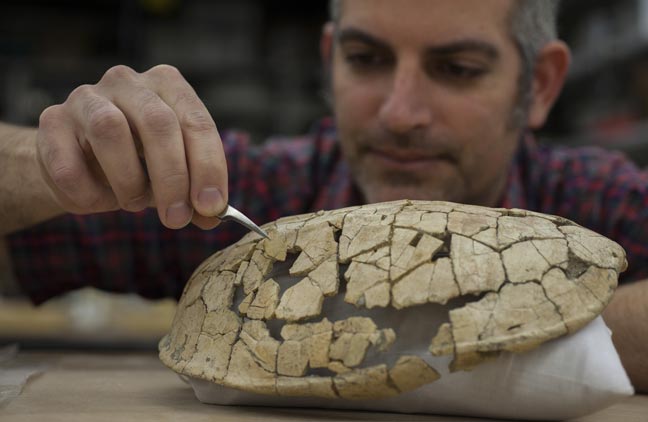Climate-Change Clues From the Turtles of Tropical Wyoming

Photo by Jeff Gage/Florida Museum of Natural History University of Florida paleontologist Jason Bourque reconstructs the 56-million-year-old shell of a newly described genus and species of ancient tropical turtle in his lab on Feb. 9, 2015. The fossil turtle gives clues to how today’s species might react to warming habitats.
While the fossil turtle and its kin could move northward with higher temperatures, human pressures and habitat loss could prevent a modern-day migration, leading to the extinction of some modern species.
The newly discovered genus and species, Gomphochelys (pronounced gom-fo-keel-eez) nanus – provides a clue to how animals might respond to future climate change, said Jason Bourque, a paleontologist at the Florida Museum of Natural History at UF and the lead author of the study, which appears online this week in the Journal of Vertebrate Paleontology.
The wayfaring turtle was among the species that researchers believe migrated 500-600 miles north 56 million years ago, during a temperature peak known as the Paleocene-Eocene Thermal Maximum. Lasting about 200,000 years, the temperature peak resulted in significant movement and diversification of plants and animals.
“We knew that some plants and lizards migrated north when the climate warmed, but this is the first evidence that turtles did the same,” Bourque said. “If global warming continues on its current track, some turtles could once again migrate northward, while others would need to adapt to warmer temperatures or go extinct.”
The new turtle is an ancestor of the endangered Central American river turtle and other warm-adapted turtles in Belize, Guatemala and southern Mexico. These modern turtles, however, could face significant roadblocks on a journey north, since much of the natural habitat of these species is in jeopardy, said co-author Jonathan Bloch, a Florida Museum curator of vertebrate paleontology.
“If you look at the waterways that turtles would have to use to get from one place to another, it might not be as easy as it once was,” Bloch said. “Even if the natural response of turtles is to disperse northward, they have fewer places to go and fewer routes available.”
To put the new turtle in evolutionary context, the researchers examined hundreds of specimens from museum collections around the country, including turtles collected during the 1800s housed at the Smithsonian Institution. Co-author Patricia Holroyd, a vertebrate paleontologist at the University of California, Berkeley, said the fossil history of the modern relatives of the new species shows they could be much more wide-ranging, if it were not for their restricted habitats.
The Central American river turtle is one of the most endangered turtles in the world, threatened by habitat loss and its exploitation as a human food source, Holroyd said.
“This is an example of a turtle that could expand its range and probably would with additional warming, but — and that’s a big but — that’s only going to happen if there are still habitats for it,” she said.
Contact Information
Writer: Stephenie Livingston, slivingston@flmnh.ufl.edu
Source: Jonathan Bloch, 352-514-1270, jbloch@flmnh.ufl.edu
Media Contact
All latest news from the category: Ecology, The Environment and Conservation
This complex theme deals primarily with interactions between organisms and the environmental factors that impact them, but to a greater extent between individual inanimate environmental factors.
innovations-report offers informative reports and articles on topics such as climate protection, landscape conservation, ecological systems, wildlife and nature parks and ecosystem efficiency and balance.
Newest articles

NASA: Mystery of life’s handedness deepens
The mystery of why life uses molecules with specific orientations has deepened with a NASA-funded discovery that RNA — a key molecule thought to have potentially held the instructions for…

What are the effects of historic lithium mining on water quality?
Study reveals low levels of common contaminants but high levels of other elements in waters associated with an abandoned lithium mine. Lithium ore and mining waste from a historic lithium…

Quantum-inspired design boosts efficiency of heat-to-electricity conversion
Rice engineers take unconventional route to improving thermophotovoltaic systems. Researchers at Rice University have found a new way to improve a key element of thermophotovoltaic (TPV) systems, which convert heat…



